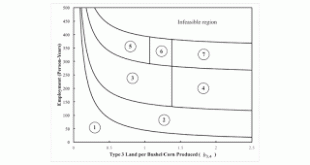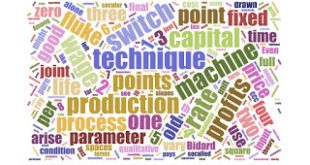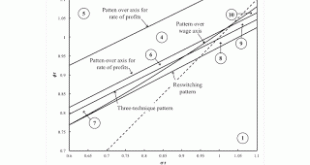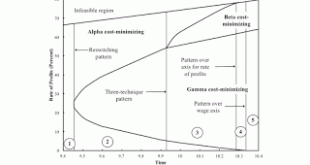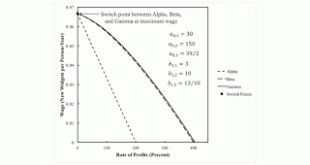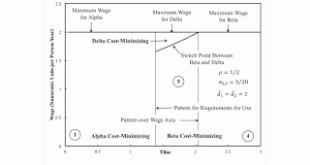[embedded content]Victor Magarino Debating "Ubersoy" On The Labor Theory Of Value The above is one in a series (Richard Wolff versus "Destiny", Slavoj Zizek versus Jordan Peterson) in which the pro-capitalist/anti-socialist side is represented by somebody seemingly almost completely ignorant of the topic they are pretending to discuss. Magarino needs a better interlocutor. I can find some related debates on YouTube with a more level playing field. That said, I think Magarino needs a...
Read More »Flukes In An Example With Land
Figure 1: A Partition of a Slice of the Parameter Space1.0 Introduction This post tells a story in which owners of a certain type of land find the amount of their land needed to produce net output declines. Wages stay constant, and the rent for some landlords increases. This example is generalized from Woods (1990). 2.0 Technology This an example (Table 1) of a capitalist economy in which two commodities, iron and corn, are produced. One process is known for producing iron. In the iron...
Read More »Three Mistakes Made By Marx
1.0 Introduction I have previously considered some points on which Marx is vulnerable. In this post, I mention three mistakes. I take the first from Joan Robinson and probably the second point too. I take the third from Ajit Sinha. The second is perhaps the least original. You can find lots of stupid stuff and nonsense about Marx. Pointing out these particular mistakes is beyond many. To have an opinion about these points, one must read Marx. One might even accept that Marx is mistaken...
Read More »Fluke Switch Points in Pure Fixed Capital Systems
I have a working paper at the Centro Sraffa. Abstract: This article considers structural economic dynamics, in models with fixed capital and a choice of technique, of the production of commodities. Fluke switch points are described and cataloged. For fluke switch points, parameter perturbations create a qualitative change in how the choice of technique varies with distribution. Techniques are presented for visualizing partitions of parameter spaces such that the analysis of the choice of...
Read More »The Tractor-Corn Model: A Start
1.0 Introduction In my ROBE article, I consider fluke switch points arising from perturbations of coefficients of production in the Samuelson-Gargenani model, but in the case with only circulating capital. An obvious generalization is to consider fixed capital. This generalization is simplified by restricting oneself to the case in which machines operate with constant efficiency. Steedman (2020) analyzes this case, and this post is a start on working through elements of the corn-tractor...
Read More »The Truncation Of The Economic Lives Of Machines
'Paradoxes' and 'Perversities' PhenomenonExampleRegionReswitching'One good'5Schefold reswitching3Schefold roundabout3Baldone8Recurrence of technique (without reswitching)Baldone9Recurrence of truncation (without reswitching or recurrence of technique)Two sectors with fixed capital2Non-monotonic variation of economic life of machine (without reswitching or recurrence of technique or of truncation)Baldone10'Non-continuous' variation in economic life of machine associated with infinitesimal...
Read More »More On Baldone Example
Figure 1: A Two-Dimensional Pattern Diagram, Enlarged1.0 Introduction This post further generalizes an example from Salvatore Baldone.. Like an example from Bertram Schefold, I find that Baldone's example is in a wedge near the edge of the appropriate region in one of my partitions of a parameter space. I have some very complicated spreadsheets that allow me to quickly visualize the effects of varying parameters. Baldone and Schefold were working long before Visicalc, Microsoft Excel, or...
Read More »An Extension Of An Example From Salvatore Baldone
Figure 1: A Pattern Diagram, Enlarged1.0 Introduction This post looks at and generalizes an example of the recurrence of techniques by Salvatore Barone. It is an example with fixed capital illustrating the recurrence of the period of truncation. In the generalization, I find what I call patterns over the axis for the rate of profits, a patern over the wage axis, a three-technique pattern, and a reswitching pattern. Barone's example demonstrates that around a switch point, a lower rate of...
Read More »A Three-Technique Pattern Over The Wage Axis
Figure 1: Wage Frontier for a Fixed Capital Example This post presents a perturbation of parameters in a 'one good' model of fixed capital. The coefficients of production differ from those in this reswitching example. But the model has the same structure. Consider a one-commodity economy in which labor and widgets are used to produce new widgets, the only consumption good. (The use of the term 'widget' to designate the single produced commodity emphasizes how unrealistic this model is.)...
Read More »Visualizing The Effects Of Parameter Perturbations In Models Of Joint Production
A Temporal Path I have a new working paper. Abstract: This article illustrates the analysis of prices of production with joint production by a numerical example. The example is used to illustrate the applicability of techniques to identify and visualize qualitative changes in the choice of technique with parameter perturbations. Patterns of switch points are knife-edge or fluke cases in which any perturbation of parameters results in such a qualitative change. This article identifies a new...
Read More » Heterodox
Heterodox

